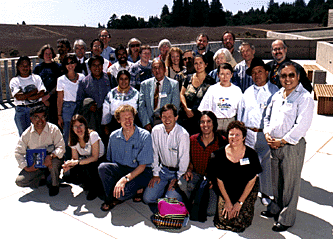![[Currents header graphic]](/homeart/currents_header.gif)
![[Currents header graphic]](/homeart/currents_header.gif)
October 6, 1997

|
|
Scholars from around the world discussed Quechua art
|
Twenty-five scholars from around the world convened at UCSC's Music Center in early September for a conference titled "The Quechua Expressive Art: Creativity, Analysis, and Performance."
The UCSC conference examined historical and contemporary Quechua musical and verbal artistic forms in song, dance, poetry, narrative, folktale, myth, and riddle from both scholarly and performance perspectives. The Quechua (pronounced ket-shwa), inhabit the Andean regions of Colombia, Ecuador, Peru, Bolivia, and northwest Argentina, and are the largest Native American culture in the Western Hemisphere, with an estimated population of between 10 and 13 million people.
Performances, panel sessions, and round-table discussions featured scholars from Bolivia, Brazil, Colombia, Ecuador, Germany, the Netherlands, Peru, Switzerland, the United Kingdom, and the U.S. According to conference co-organizer John Schechter, UCSC associate professor of music, participants represented the disciplines of anthropology, ethnomusicology, ethnohistory, folkloristics, linguistics, and literature.
Organizing the conference with Schechter was Guillermo Delgado, UCSC lecturer in Latin American and Latino studies. Schechter noted that several generations of scholars in the field attended the conference, representing not only a range of disciplines and cultures, but a variety of approaches to research, which often became the subject of discussion.
The conference concluded on the evening of September 6 with musical performances of Andean and Quechuan music. Performers included UCSC's Latin American Ensemble, Taki Nan, directed by Schechter; Chaskinakuy, a professional, California-based husband-and-wife duo specializing in Andean musics; and Patricio Cuji Guallinga, an Ecuadorian Canelos (lowland) Quechua musician.
Schechter felt that the conference has served as a starting point for further exchanges. "Participants came away from the symposium with a sense that it had constituted the first of its kind, a feat of organization and dynamism. It opened a path to further exchanges that have the capacity to decenter power relations and allow for fruitful comparison, debate, and reflection," he noted.
The conference was supported by the UC Humanities Research Institute, the UCSC Divisions of Arts and Social Sciences, the Music Department, and the Chicano/Latino Research Center.